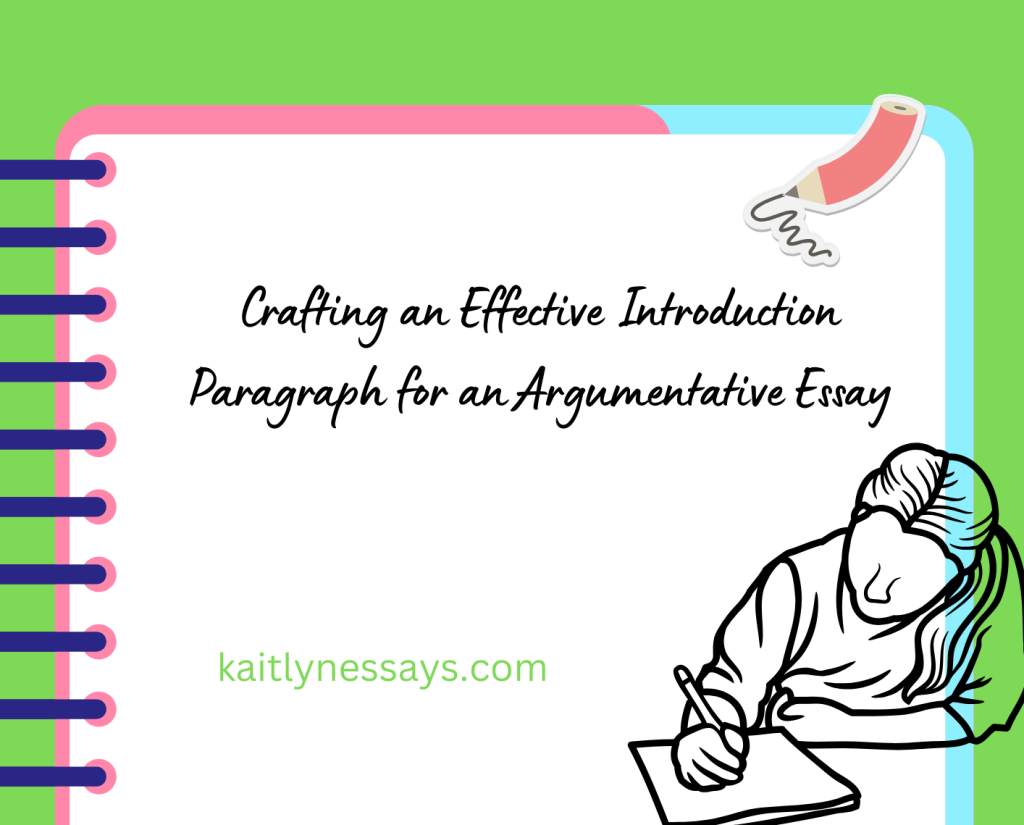Introduction
In the realm of academic writing, mastering the art of crafting an effective introduction paragraph is indispensable. Especially in argumentative essays, where the writer aims to persuade readers of a particular viewpoint, the introduction plays a pivotal role in setting the tone, presenting the issue at hand, and outlining the argument to follow. A well-structured introduction not only captures the reader’s attention but also provides a roadmap for the essay’s progression. In this guide, we will explore the components and strategies essential for writing a compelling introduction paragraph for an argumentative essay.
Before looking into the intricacies of crafting an introduction paragraph, it is crucial to understand its primary purpose. The introduction serves as the gateway to the argumentative essay, providing essential background information, framing the topic, and presenting the writer’s thesis statement. Additionally, the introduction aims to engage the reader’s interest and establish the essay’s relevance and significance.

Components of an Effective Introduction Paragraph
To effectively engage the reader and set the stage for the argumentative essay, the introduction paragraph should consist of several key components:
1. Hook
The hook serves as the opening line of the introduction, designed to capture the reader’s attention and pique their interest in the topic. It can take various forms, including a compelling statistic, an intriguing question, a relevant anecdote, or a thought-provoking quotation. By beginning with a captivating hook, the writer can draw the reader into the essay and compel them to continue reading.
2. Background Information
Following the hook, the introduction should provide essential background information to contextualize the topic for the reader. This may include relevant historical or factual information, key definitions or concepts, and any necessary context to understand the argument being presented. By providing background information, the writer ensures that readers are adequately informed and prepared to engage with the essay’s argument.
3. Thesis Statement
Arguably the most crucial component of the introduction paragraph is the thesis statement. This concise and declarative statement articulates the writer’s main argument or position on the issue at hand. It serves as the focal point of the essay, guiding the reader on what to expect and outlining the main points that will be addressed in the subsequent body paragraphs. A well-crafted thesis statement is clear, specific, and debatable, setting the stage for a compelling argument.
4. Scope and Significance
In addition to presenting the thesis statement, the introduction should briefly outline the scope and significance of the argumentative essay. This involves explaining why the topic is relevant or timely, discussing its broader implications, and highlighting the stakes involved in the debate. By elucidating the importance of the topic, the writer can motivate readers to engage with the essay and consider its implications.
Strategies for Writing an Effective Introduction

Crafting an effective introduction paragraph requires careful planning and attention to detail. To enhance the impact of the introduction and engage the reader from the outset, writers can employ several strategies:
1. Conduct Preliminary Research
Before drafting the introduction, it is essential to conduct preliminary research on the topic to gather relevant information and insights. This may involve reviewing academic sources, analyzing data or statistics, and familiarizing oneself with existing arguments and perspectives on the issue. By conducting thorough research, writers can ensure that their introduction is well-informed and effectively sets the stage for the argumentative essay.
2. Choose an Engaging Hook
Selecting an engaging hook is crucial for capturing the reader’s attention and drawing them into the essay. Writers should consider various options, such as startling facts or statistics, provocative questions, vivid descriptions, or compelling quotations. The key is to choose a hook that is relevant to the topic and resonates with the reader, sparking their curiosity and compelling them to continue reading.
3. Provide Concise Background Information
Incorporating concise background information is essential for contextualizing the topic and ensuring that readers have the necessary context to understand the argument. However, it is crucial to strike a balance and avoid overwhelming the reader with excessive detail. Writers should focus on providing essential background information that directly relates to the argumentative essay’s thesis statement and main points.
4. Craft a Clear and Concise Thesis Statement
The thesis statement is the cornerstone of the introduction paragraph, encapsulating the main argument or position that the essay will defend. To ensure clarity and effectiveness, writers should craft a thesis statement that is specific, debatable, and supported by evidence. Additionally, the thesis statement should be placed prominently at the end of the introduction, clearly signaling to the reader the essay’s focus and direction.
5. Establish Relevance and Significance
Finally, writers should strive to establish the relevance and significance of the argumentative essay within the introduction paragraph. This involves explaining why the topic matters, discussing its broader implications, and highlighting the stakes involved in the debate. By establishing relevance and significance, writers can motivate readers to engage with the essay and consider its implications for the broader discourse.
Incorporating External Sources

To bolster the credibility and persuasive power of the argumentative essay, writers can integrate external sources into the introduction paragraph. These sources may include academic articles, books, expert opinions, and empirical data that support the writer’s argument and provide additional context for the topic. When incorporating external sources, it is essential to adhere to proper citation guidelines, such as MLA format, to give credit to the original authors and avoid plagiarism.
Example of MLA Citation for an External Source:
Smith, John. “The Impact of Climate Change on Global Agriculture.” Journal of Environmental Studies, vol. 25, no. 2, 2020, pp. 45-60.
Incorporating external sources not only adds credibility to the argumentative essay but also demonstrates the writer’s engagement with existing research and scholarship on the topic. By citing authoritative sources, writers can strengthen their argument and provide readers with additional evidence and insights to consider.
Addressing Counterarguments
In addition to presenting the main argument, the introduction paragraph of an argumentative essay should also acknowledge and address potential counterarguments. This demonstrates the writer’s awareness of alternative perspectives and enhances the overall persuasiveness of the essay. By preemptively addressing counterarguments, writers can strengthen their own argument and anticipate and refute potential objections raised by readers.
Example of Addressing Counterarguments:
While some may argue that implementing stricter gun control laws infringes on individual liberties, it is important to recognize that such measures are necessary to address the alarming rise in gun-related violence and protect public safety.
By acknowledging and refuting potential counterarguments within the introduction paragraph, writers can preemptively address readers’ concerns and build a more persuasive case for their own argument.
Conclusion
Crafting an effective introduction paragraph for an argumentative essay is essential for engaging readers, presenting the main argument, and setting the stage for the essay’s progression. By incorporating key components such as a compelling hook, background information, a clear thesis statement, and an acknowledgment of counterarguments, writers can effectively capture the reader’s attention and establish the relevance and significance of the essay’s topic. Additionally, integrating external sources and adhering to proper citation guidelines enhances the credibility and persuasiveness of the argumentative essay. Ultimately, a well-crafted introduction lays the foundation for a coherent and compelling argument that convinces readers of the writer’s viewpoint.
If you’re struggling to draft your essay, consider seeking assistance from our experts at kaitlynessays.com. We specialize in crafting professional academic essays and papers of all types, ensuring top-notch quality for our clients.
FAQs
- What is the purpose of the introduction paragraph in an argumentative essay?
- The introduction paragraph serves several purposes, including capturing the reader’s attention, providing background information on the topic, presenting the writer’s thesis statement, and outlining the scope and significance of the essay.
- What should I include in the introduction paragraph of an argumentative essay?
- The introduction paragraph should include a hook to capture the reader’s attention, background information to contextualize the topic, a clear thesis statement outlining the main argument, and a brief overview of the essay’s scope and significance.
- How can I grab the reader’s attention in the introduction paragraph?
- You can grab the reader’s attention by using a compelling hook, such as a startling fact or statistic, an intriguing question, a relevant anecdote, or a thought-provoking quotation.
- What makes a good thesis statement for an argumentative essay?
- A good thesis statement for an argumentative essay is clear, specific, debatable, and supported by evidence. It should articulate the writer’s main argument or position on the topic and provide a roadmap for the essay’s progression.
- Should I address counterarguments in the introduction paragraph?
- Yes, it is beneficial to address counterarguments in the introduction paragraph of an argumentative essay. This demonstrates the writer’s awareness of alternative perspectives and enhances the persuasiveness of the essay by preemptively addressing potential objections.
- How can I incorporate external sources into the introduction paragraph?
- You can incorporate external sources into the introduction paragraph by citing relevant academic articles, books, expert opinions, or empirical data that support your argument. Be sure to adhere to proper citation guidelines, such as MLA format, to give credit to the original authors.
- What is the ideal length for an introduction paragraph in an argumentative essay?
- The ideal length for an introduction paragraph can vary depending on the complexity of the topic and the overall length of the essay. However, a concise introduction paragraph typically ranges from three to five sentences.
- How can I ensure that my introduction paragraph is effective?
- To ensure that your introduction paragraph is effective, carefully plan and organize your thoughts, conduct preliminary research on the topic, choose an engaging hook, provide concise background information, craft a clear thesis statement, address counterarguments, and integrate external sources when appropriate.
- Should I revise my introduction paragraph after completing the essay?
- Yes, it is recommended to revise your introduction paragraph after completing the essay to ensure that it accurately reflects the content and argument presented in the body paragraphs. Make any necessary adjustments to the introduction to maintain coherence and clarity.
- Where can I find additional resources on writing introduction paragraphs for argumentative essays?
- You can find additional resources on writing introduction paragraphs for argumentative essays in academic writing guides, online writing tutorials, and scholarly articles on essay composition and argumentation.
